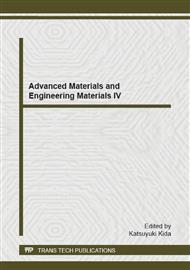[1]
Hull D, A unified approach to progressive crushing of fibre-reinforced composite tubes, Composites Science and Technology. 40 (1991) 377-421.
DOI: 10.1016/0266-3538(91)90031-j
Google Scholar
[2]
Mamalis A G, Robinson M, Manolakos D E, Crashworthy capability of composite material structures, Composite Structures. 37(1997)109-134.
DOI: 10.1016/s0263-8223(97)80005-0
Google Scholar
[3]
Schultz M R, Hyer M W, Static energy absorption capacity of graphite-epoxy tubes, Journal of Composite Materials. 35-19(2001)1747-1761.
DOI: 10.1106/0hvr-yamu-5r44-hbh2
Google Scholar
[4]
Carruthers J J, Kettle A P, Robinson A M, Energy absorption capability and crashworthiness of composite material structures: a review, Applied Mechanics Reviews. 51(1998)635-649.
DOI: 10.1115/1.3100758
Google Scholar
[5]
Feraboli P, Wade B, Deleo F, Rassaian M, Crush energy absorption of composite channel section specimens, Composites Part A. 40(2009)1248–1256.
DOI: 10.1016/j.compositesa.2009.05.021
Google Scholar
[6]
WANG Qingchun, FAN Zijie, Improvement in analysis of quasi-static collapse with LS-DYNA, Mechanics in Engineering. 25-3(2003)20-23[in Chinese].
Google Scholar
[7]
BATHE, K J, GUILLERMIN, O and CHEN, H Y, Advances in nonlinear finite element analysis of automobiles, Computers & Structures. 64(1997)881–891.
DOI: 10.1016/s0045-7949(97)00035-7
Google Scholar
[8]
BATHE, K J, WALCZAK, J and GUILLERMIN, Advances in crush analysis, Computers & Structures. 72(1999)31–47.
DOI: 10.1016/s0045-7949(99)00041-3
Google Scholar
[9]
M. LANGSETH, O.S. HOPPERSTAD, T. BERSTAD, Crashworthiness of aluminium extrusions: validation of numerical simulation, effect of mass ratio and impact velocity, International Journal of Impact Engineering. 22(1999)829–854.
DOI: 10.1016/s0734-743x(98)00070-0
Google Scholar
[10]
H El-Hage, P K Mallick and N Zamani, A numerical study on the quasi-static axial crush characteristics of square aluminum tubes with chamfering and other triggering mechanisms, International Journal of Crashworthiness. 10-2(2010) 183-196.
DOI: 10.1533/ijcr.2005.0337
Google Scholar
[11]
Jiancheng Huang, Xinwei Wang, Numerical and experimental investigations on the axial crushing response of composite tubes, Composite Structures. 91(2009)222–228.
DOI: 10.1016/j.compstruct.2009.05.006
Google Scholar
[12]
Hamidreza Zarei, Matthias Kröger, Henrik Albertsen, An experimental and numerical crashworthiness investigation of thermoplastic composite crash boxes, Composite Structures. 85(2008) 245–257.
DOI: 10.1016/j.compstruct.2007.10.028
Google Scholar
[13]
A.G. Mamalis, D.E. Manolakos, M.B. Ioannidis, D.P. Papapostolou, The static and dynamic axial collapse of CFRP square tubes: Finite element modeling, Composite Structures. 74(2006) 213–225.
DOI: 10.1016/j.compstruct.2005.04.006
Google Scholar
[14]
H El-Hage, P K Mallick and N Zamani, Numerical modelling of quasi-static axial crush of square aluminium-composite hybrid tubes, International Journal of Crashworthiness. 9-6(2009)653-664.
DOI: 10.1533/ijcr.2004.0320
Google Scholar
[15]
Haipeng Han, Farid Taheri, Neil Pegg, You Lu, A numerical study on the axial crushing response of hybrid pultruded and ±45braided tubes, Composite Structures. 80(2007)253–264.
DOI: 10.1016/j.compstruct.2006.05.012
Google Scholar
[16]
H. El-Hage, P.K. Mallick, N. Zamani, A numerical study on the quasi-static axial crush characteristics of square aluminum–composite hybrid tubes, Composite Structures. 73(2006) 505–514.
DOI: 10.1016/j.compstruct.2005.03.004
Google Scholar
[17]
A.G. Mamalis, D.E. Manolakos, M.B. Ioannidis, P.K. Kostazos, D.P. Papapostolou, Axial collapse of hybrid square sandwich composite tubular components with corrugated core: numerical modeling, Composite Structures. 58(2002)571–582.
DOI: 10.1016/s0263-8223(02)00166-6
Google Scholar
[18]
A.G. Mamalis, D.E. Manolakos, M.B. Ioannidis, P.K. Kostazos, Crushing of hybrid square sandwich composite vehicle hollow body shells with reinforced core subjected to axial loading: numerical simulation, Composite Structures. 61(2003)175–186.
DOI: 10.1016/s0263-8223(03)00069-2
Google Scholar


